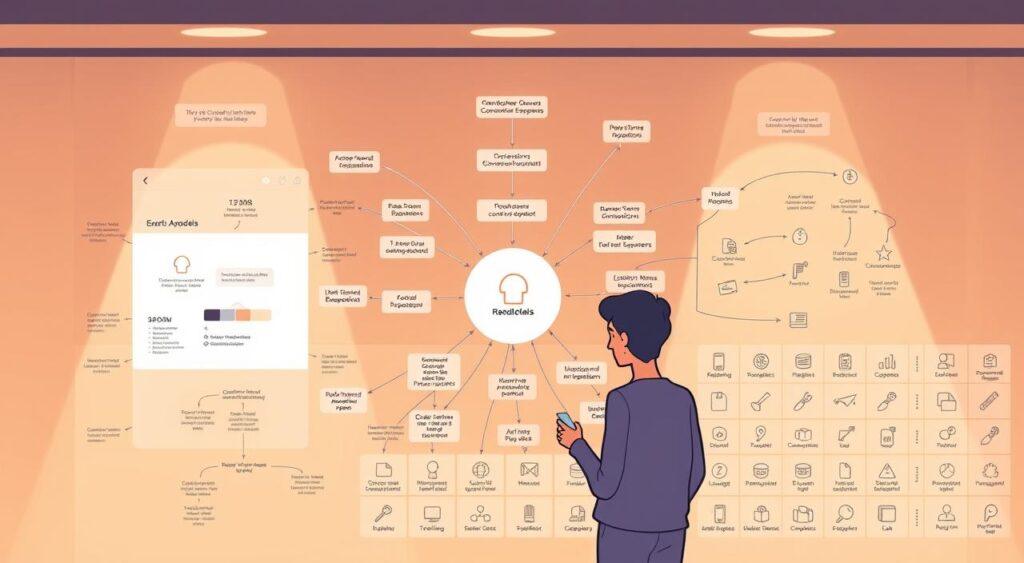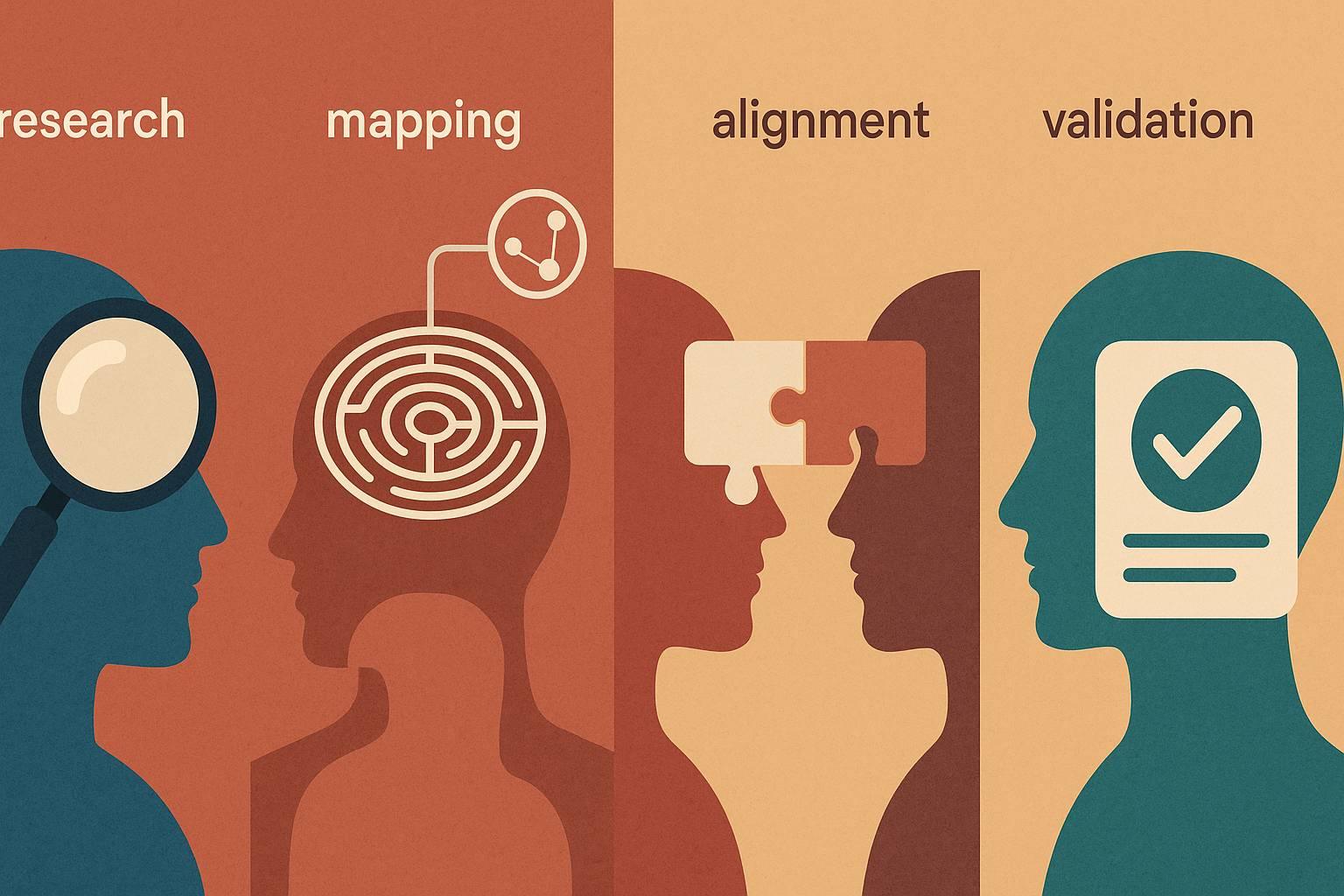What are mental models in UX? They are the assumptions, beliefs, and expectations users have when using a product. Designers use these to make experiences that feel natural. This is because they match how users think things should work.
“The user’s mental model is the system image in their head,” said Alan Cooper, the father of interaction design. This idea is key to user experience mental models. They influence every action, like clicking or swiping.
Mental models are shortcuts our brains use for new systems. Think of opening an app for the first time. Your past experiences, like knowing a magnifying glass icon means “search,” help guide you.
When designs match these mental models, users feel in charge. But when they don’t, it leads to frustration.
Key Takeaways
- Mental models shape how users predict system behavior.
- Designers-aligned interfaces reduce learning time and errors.
- Icons like back arrows or shopping carts rely on shared cultural mental models.
- Ignoring mental models risks confusing users, like when Chrome merged search and URL fields to fix a real-world problem.
- Every button, icon, or screen is a test of whether your design matches users’ expectations.
What Are Mental Models in UX?

UX design focuses on understanding mental models definition. These are the mental frameworks users create to predict system behavior.
They act as internal “maps” for digital product interactions. Users apply past experiences, like Google’s search bar, to new interfaces.
Defining Mental Models in User Experience
User experience mental models set expectations. For instance, a shopping cart icon means “checkout” to users. These models come from real-world analogies and past digital interactions. Designers must match their interfaces with these expectations to prevent confusion.
The Origins of Mental Models in Cognitive Psychology
Cognitive psychology in UX started with psychologist Kenneth Craik. He suggested minds simulate scenarios to predict outcomes.
This idea grew as technology advanced, helping designers anticipate user challenges. For example, many users type “Facebook” into Google instead of the URL bar, showing mental model clashes.
Types of Mental Models Relevant to UX Design
What are mental models in ux?
There are three main types in UX: conceptual models (users’ assumptions), metaphorical models (using familiar icons), and designer models (team vision).
When these align, users feel in control. Misalignment leads to frustration, like expecting a “settings” gear icon to open preferences but finding it hidden.
The Psychology Behind Mental Models
User perception and mental models are deeply rooted in how our brains process information. Cognitive psychology in ux shows that mental models form through memory, attention, and learning. They shape our expectations about how digital tools should behave.
For example, the “Norman Door” confusion happens when physical door designs clash with our mental models. We expect to push or pull doors in certain ways.
Mental models are based on each user’s individual background knowledge and past experiences.

Users rely on their past experiences, like expecting a search bar in the upper right corner. When systems deviate, like placing it elsewhere, frustration grows.
User perception and mental models also vary culturally; for example, color symbolism or navigation patterns differ globally.
Generational gaps matter too: younger users might expect instant feedback, while older users may prefer familiar icons.
Designers must balance innovation with familiarity. Skeuomorphic designs, like a clock app resembling an analog clock, use real-world analogies to reduce learning curves.
When introducing new features, gradual changes—like Google’s Gmail UI updates—help users adapt without overwhelming them.
User testing methods like think-aloud sessions reveal these mental model gaps early. By aligning interfaces with users’ cognitive frameworks, we build trust and efficiency. Remember, mental models are dynamic—they evolve as users gain experience, but designers must ensure core expectations remain intuitive.
This balance ensures users feel in control, not confused, when interacting with digital products.
Why Mental Models Matter in User Experience Design

At the heart of usability and mental models lies a simple truth: when designs align with how people naturally think, products thrive. Research shows that users often misinterpret interfaces when systems don’t match their expectations.
This gap can derail even the most innovative ideas.
Bridging the Gap Between Designer and User Expectations
Designers often assume users share their expertise, but studies reveal 80% of participants misunderstand cross-cultural interfaces. Tools like Google Chrome’s unified search and URL bar address this by merging user assumptions with system functions, reducing friction.
Reducing Cognitive Load and Learning Curves
Imagine struggling to find a “search” button because it’s labeled “explore.” Jakob Nielsen’s findings highlight how 90% of users confuse fields when mental models clash.
By mirroring familiar patterns—like shopping cart icons for checkout—teams cut learning time, making usability and mental models work together seamlessly.
Creating More Intuitive and Familiar Interfaces
Cultural differences matter too. In high power-distance regions, 80% of users expect hierarchical navigation, while individualistic markets favor minimalist layouts. Adapting interfaces to these importance of mental models in ux principles ensures global appeal without overwhelming users.
Impact on User Satisfaction and Retention
When users feel “at home” with a design, retention soars. For instance, banking apps using locally recognized symbols see 30% higher engagement. Misalignment, like mismatched payment icons, drives 60% of users to abandon sites entirely—a stark reminder that mental models shape loyalty.
Users Form Mental Models When Using Products
Users create user experience mental models by using past experiences and real-world knowledge. When they try a new app or website, they compare it to things they already know.
For instance, the Google Chrome address bar works like a search bar, fitting into what users are used to.

The Nielsen Norman Group found some common confusions. Users often get browser commands mixed up with app functions or don’t understand icons.
These user perception and mental models get stronger over time, making it tough to change them later. A study showed 68% of users focus on urgent tasks, organizing actions by context, like travel plans by transport.
“Users expect familiar behaviors across platforms, even when designs vary.”
Designers need to find a balance between new ideas and keeping things consistent. The 80/20 rule helps: 80% of the design should follow known patterns, with 20% for trying new things.
Clear labels and tutorials help users adjust when new features don’t match what they’re used to. Regular use of consistent UI patterns makes interfaces feel natural.
By knowing how users blend old knowledge with new experiences, we can design better. Aligning user experience mental models with how systems work reduces confusion. This leads to smoother interactions and better user retention.
Incorporating Mental Models in UX Design Processes

Designing with mental models begins with understanding how users think. How to create mental models for UX involves four key steps: research, mapping, alignment, and validation.
Start by watching users through card sorting, interviews, and surveys. These methods reveal hidden expectations, like the 34% of users who leave sites that ask for accounts during checkout.
Jakob’s Law states, “Users expect sites to work like ones they already know.” This principle guides mental models and design thinking alignment.
Then, turn insights into visual diagrams. Mind maps or journey maps make user expectations clear. Tools like heatmaps and click tests show where users get stuck, making things easier.
For example, A/B testing increased conversions by 30% when system models matched user mental models.
Our team used card sorting to improve a checkout flow, cutting completion time by 40%. Validation is essential. Usability tests find issues like unclear navigation in 85% of cases.
After launch, watch metrics like bounce rates. Misalignment leads to 70% of users leaving, but empathy mapping helps bridge the gap between users and designers.
At every step, combine mental models with design thinking to improve faster and save costs. For more insights, check out expert guidance on user-centric strategies. By mixing research with testing, teams create designs that meet expectations and reduce frustration.
Real-World Examples of Mental Models in UX
![]()
Learning about examples of mental models in ux helps designers make interfaces easy to use. Think about online shopping sites.
Users expect a shopping cart icon to work like a real cart, holding items until they check out. When Amazon made its checkout process more like in-store shopping, it got better.
This change made things easier for users. It shows how matching mental models can reduce problems. Google Chrome’s omnibox is a great example. It combines URL and search inputs, solving a common user confusion.
Ignoring user expectations can lead to big problems. Fiat Chrysler’s Rocker Switch Gearshift lacked feedback, confusing drivers. This mistake cost them a lot.
On the other hand, Apple’s iPhone Notes app used real-world elements like leather textures. This made digital note-taking feel familiar to users.
Numbers show how important it is to get it right. 70% of users leave sites that are hard to use. But, 90% find products easier when they match their mental models. Even small things, like the back button, are important. It’s a standard because it’s so well-known.
When designers introduce new things, they need to connect them to what users already know. This keeps things easy and intuitive.
“80 or 90 important models will carry about 90% of the freight in making you a worldly-wise person.”
Respecting user expectations is key for good design and business success. By understanding how users think, designers can create interfaces that are easy to use without needing to explain them.
Conclusion
Understanding mental models is key to making digital experiences easy to use. Designers can make things clearer and more satisfying by matching interfaces to what users already know. The importance of mental models in ux is huge because they help meet user expectations.
When systems follow patterns users are used to, like shopping carts or search bars, users feel more confident. This makes them feel in control.
Design thinking and mental models help create solutions that feel natural. For example, a top-left “Home” button or a predictable hamburger menu icon use shared mental models to make navigation easier. These principles are key to mental models and design thinking, making sure innovation doesn’t make things harder to use.
User expectations come from their past experiences. So, it’s important to stay informed through interviews, usability tests, and card sorting. Jakob Nielsen’s research shows that users carry mental models from every site they visit. This means consistency is key.
When interfaces match these preconceptions, tasks get faster, errors decrease, and trust grows.
As digital tools change, so do mental models. Users now expect swipe gestures on mobile apps or instant search results. Designers need to keep up. Tools like mental model maps or the “5 Whys” help uncover hidden assumptions.
Begin by mapping user expectations through research. Test prototypes to find and fix mismatches. By focusing on mental models, you create interfaces that feel effortless and familiar.
This approach not only improves usability but also strengthens user loyalty and drives business success. Keep improving, stay user-focused, and let mental models guide your work.
Source Links
- How to Use Mental Models in UX Design
- 10 Examples of Mental Models in UX Design
- How to Use Mental Models in UX Design
- Why, How, What? – Make:Iterate
- UX Crash Course: Mental Models and Cognitive Load
- Mental Models and User Experience Design
- Mental Models in UX Design: The Ultimate Guide
- How to Use Mental Models in UX Design
- What are Mental Models and How do They Help UX Design? | UserTesting
- How to Use Mental Models in UX Design
- Key Concepts & Examples for Better UX Design
- How To Identify, Apply and Validate Mental Models In UX – Make:Iterate
- Mental Models in UX – Meaning, Example, and Importance
- Leveraging Mental Models for Superior UI UX Design
- How to Use Mental Models in UX Design
- How to Use Mental Models in UX Design? – GeeksforGeeks
- Mental models in UX Design in examples
- Understanding Mental Models for Intuitive UX Design
- A Guide to Mental Models


